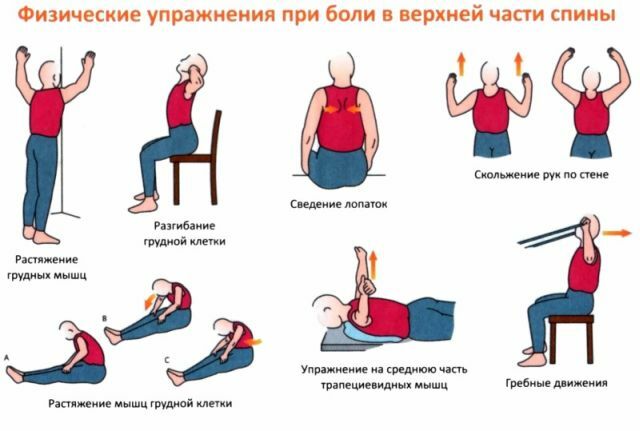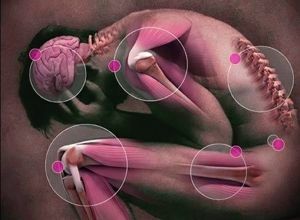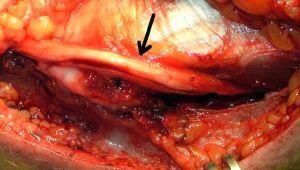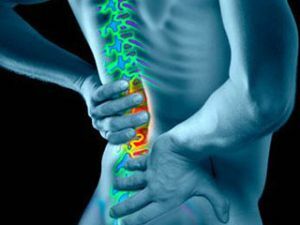 If you become aware of frequent back pain, you should consult a specialist and undergo an appropriate examination, as the reasons may be different, often associated with changes in the spine and its segments.
If you become aware of frequent back pain, you should consult a specialist and undergo an appropriate examination, as the reasons may be different, often associated with changes in the spine and its segments.
The pain syndrome can be caused by the jamming of the nerve roots, which are located between the vertebrae and originate from the spinal nerves.
This clinical picture characterizes the emergence of radiculopathy - a disease that often occurs in middle-aged people.
Contents of the article
- General information
- Etiology of radiculopathy
- Two forms of pathology
- What are the true causes of pathology?
- Symptoms depending on location
- Cervical spine
- Thoracic spine
- Lumbar spine
- Diagnostic techniques
- Approach to treatment
- Complications of the disease
- Preventive measures
General information
The disease of radiculopathy is the second somewhat simplified name - "radiculitis".Pathology characterizes any pathology of the spinal nerve roots.
In the process of degeneration of the intervertebral discs, their exhaustion and thinning occurs, which leads to a loss of that initial depreciation and elasticity of the spine.
During the presented processes, the affected segments feel pressure, which causes a decrease in the distance between the vertebrae and provokes irritation, and then the infringement of nerve endings.
Such changes in the body lead to the onset of pain and, in case of neglected state and untimely intervention, partial or complete immobility.
Etiology of radiculopathy
The disease is provoked by age-related changes, where depletion and loss of the original properties and functions of intervertebral discs is observed.
Infringement of nerve roots occurs due to adverse effects on them, where in addition to segments of the spine, hernias, osteophytes or osteochondrosis can participate.
Two forms of pathology
Radiculopathy has two varieties: vertebrogenic and discogenic. The forms of manifestation of the disease are based on the same causes and often have the same symptoms.
What are the differences between the presented varieties?
Initially degenerative processes in the spine lead to the appearance of discogenic radiculopathy, where one or several roots are infringed, by thinning the intervertebral disc, bulging it, or falling out.
The secondary form of discogenic radiculopathy generates vertebrogenic formation, which determines the pressure exerted by 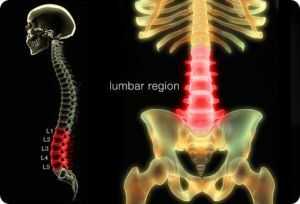 by the walls of the "tunnel" on the nerve endings of the spinal column.
by the walls of the "tunnel" on the nerve endings of the spinal column.
This pressure leads to a violation of the blood supply to the spinal cord, inflammation of the processes and edema of the muscles. Then there is loss of sensitivity and violation of reflexes.
Pain begins to spread throughout the body, irradiates to the limbs, which can sometimes lead to loss of sensitivity or even paralysis of the fingers, expressed by the inability to take a cup in hand, changes in the gait are observed.
What are the true causes of the pathology?
The disease has similar causes with the original form of its manifestation.
Here distinguish:
- sedentary lifestyle;
- hormonal disorders;
- age changes;
- chronic inflammation of human organs;
- incorrect posture;
- injuries and bruises;
- abnormalities in the structure of the spinal column;
- physical activity with frequent lifting of weights.
Vertebrogenic radiculopathy s1 also may develop as a result of hypothermia of the strangulated nerve root , so if you have already diagnosed osteochondrosis with radicular syndrome or a hernia, never undergo drafts and not stay in the cold for a long time.
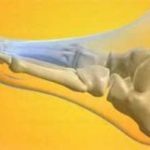 What treatment is prescribed if the patient is diagnosed with bursitis of the foot. Methods of disease prevention.
What treatment is prescribed if the patient is diagnosed with bursitis of the foot. Methods of disease prevention. Effective and effective drugs for pain in the spine of muscle relaxants of central action - a list of the best drugs and their therapeutic effects.
Symptoms depending on localization
Vertebrogenic radiculopathy l5 s1 initially manifests with pain symptoms, which, depending on the localization, have some differences.
The spine is divided into three main departments, each of which should be considered separately.
Cervical spine
If the affected nerve roots are in the cervical spine, the patient may experience not only severe pains, but immobility, which makes it impossible to move the head.
Vertebrogenic cervical radiculopathy causes swelling and inflammation of the muscles, their tension will cause suffering.
In addition, squeezing the root, leading to a violation of blood circulation, will provoke headaches, dizziness, which can occur abruptly after turning the head.
Affected roots, located in the lower part of the cervical region, will cause irradiating pain in the hands and shoulder blades. Perhaps immobilization of the limbs.
Thoracic spine
Infringement and further inflammation of the spine in the thoracic spine provokes aching pain in the abdominal cavity of the surrounding nature.
It should be noted that in the thoracic department such processes are rare, and are often caused by trauma or any other causes.
But if nevertheless the doctor diagnosed discogenic radiculopathy and the presence of a hernia, with the manifestation of abdominal pain it is necessary to consult a specialist, as a violation of blood supply and inflammatory processes can lead to an effect on the internal organs.
They are under pressure, and the supply of useful trace elements is limited. As a result of the presented processes, diseases of the internal organs arise.
Lumbosacral spine
 Vertebrogenic sciatic lumbar puncture is the most common type of pathology.
Vertebrogenic sciatic lumbar puncture is the most common type of pathology.
Restricted roots, associated with the internal organs of the small pelvis, with pressure on them begin to deliver aching pains in the area of lesion localization, as well as radiating to the gluteal region, the leg, partially immobilizing the thumb. It should be noted that the pain symptoms are permanent, disappearing only for a few moments.
Because the pain of a weak person has a feature not to pay attention to it. Such an attitude can lead to a number of health problems.
Due to the fact that the organs of the genitourinary system have a connection with the nerve roots and partial feeding from them, the pressure on the processes leads to a deficiency of useful trace elements. An irreversible process starts, where there is a violation of the hormonal background, and in neglected cases, the ability to procreate is reduced.
Diagnostic Techniques
In contrast to the first form of radiculitis, vertebrogenic radiculopathy can be diagnosed by the doctor only on the patient's complaints for pain.
This is especially possible in the presence of a hernia, osteophytes and other outgrowths on the segment and the nerve root. To confirm his diagnosis, the specialist appoints a patient to the examination with the passage of the MRI department, where the pain symptom is localized.
Approach to treatment
Treatment of vertebrogenic radiculopathy initially aims at eliminating the pain syndrome .Here the patient is prescribed all the necessary painkillers and anti-inflammatory drugs.
Of course, in connection with the clinical picture of the disease, it becomes clear that taking medications can not fully cure the patient. Medications can only temporarily remove symptoms.
Pathology is often treated only by an operative route, where the surgeon has the main task in removing outgrowths.
Then follows a long recovery with acupuncture, massage and exercise therapy. The probability of using chondroprotectors - drugs that restore the spinal segment of the disc is great.
Complications of the disease
In case of untimely intervention, the disease entails complications based on the pressure of the internal organs of the patient with subsequent disruption of their function and activity.
Pain spread all over the body can bring a lot of inconvenience to a person, which even contains a painful wiggling of his finger.
In addition, a violation of the blood supply will lead to migraines and fainting. A simple turn of the head can be accompanied by nausea and vomiting.
Preventive measures
If a specialist diagnoses your initial stage of the disease in the form of osteochondrosis, follow all of his prescriptions, which will include the use of restorative drugs, massage, and therapeutic gymnastics.

These simple rules will help you not to bring the situation to the operating table, which happens quite often.
Do not be lazy to play sports and find time for it in your busy schedule. Proper nutrition without bad habits will allow you to cure windbrogenous radiculopathy at its initial stage by taking appropriate medications.

